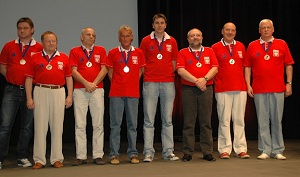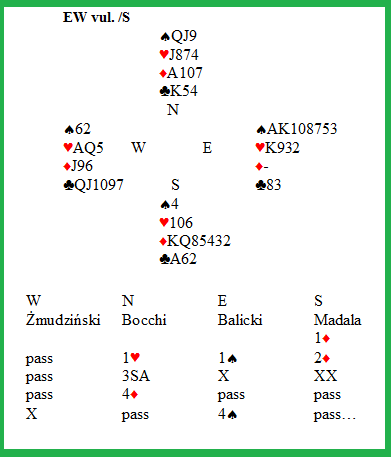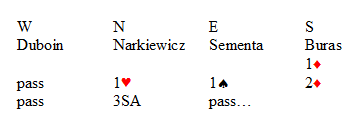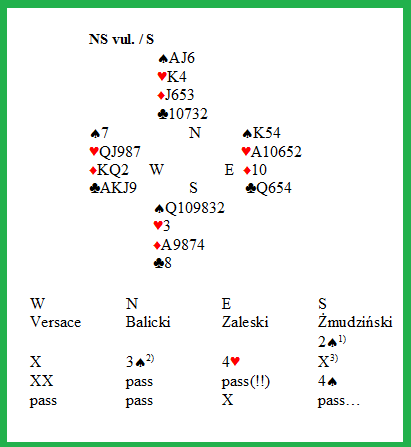czytaj po polsku» leggi in italiano »
 The Polish Open Team won Silver Medal at the 14° World Bridge Games in Lille 2012: Piotr Żak, Jerzy Zaremba, Piotr Walczak (NPC), Grzegorz Narkiewicz, Krzysztof Buras, Cezary Balicki and Adam Żmudziński. Laura Cecilia Porro wrote for Neapolitan Club a long and articulated interview to the coach Marek Wójcicki. In addition to the usual English and Italian versions, in homage to our many readers from Poland, we also publish a Polish edition of the full text.
The Polish Open Team won Silver Medal at the 14° World Bridge Games in Lille 2012: Piotr Żak, Jerzy Zaremba, Piotr Walczak (NPC), Grzegorz Narkiewicz, Krzysztof Buras, Cezary Balicki and Adam Żmudziński. Laura Cecilia Porro wrote for Neapolitan Club a long and articulated interview to the coach Marek Wójcicki. In addition to the usual English and Italian versions, in homage to our many readers from Poland, we also publish a Polish edition of the full text.
Thank you Marek for agreeing to do this interview. First of all congratulations on winning the Silver Medal in the World Bridge Games, held in Lille (France) during the past two weeks. First topic I’d like to analyze is the pairs rotation: Which strategy did you adopt for the pairs’ playing rota?
During the Round Robin the assumption was that all three pairs play a more or less equal amount of boards, with the exception of the most difficult matches – in those we would play our strongest line-up. In the knock-out phase the tactics were optimised to achieve best results, letting tired pairs/players rest in case of comfortable lead over rival.
Did you decide it in advance before each match or did you wait to see how things were going?
Most of the time we would chose line-ups for the day in the morning, but a few emergency changes took place.
Did you decide the pairs rota by yourself and informed players of your decision or did you discuss with them?
I would talk to the players about their preferences about hours of play (some of them would prefer to sleep longer, others like having afternoons off) and about opponents they would have to face. Based on that data and my own judgement I would determine optimal strategy for the remainder of the match/tournament.
Were the players ever unhappy about your decisions regarding the line-up?
It happened a few times, maybe not in the Round Robin but in some of the play off segments.
Now let’s move on the overall competition: Which has been the toughest match?
The most difficult one was definitely the match against Sweden, score being the best proof of that. Swedes played almost without committing any technical errors and their bidding was accurate. It let them build up a significant lead at the beginning of the match. And then? The Swedish team played their game consistently – solid bridge without taking excessive risks. Regarding our team: every time we tried to create a swing to turn the match around we would end up with immediate loss. In the end these attempts were rather desperate and it seemed like banging head against the wall rather than bridge – hence the high final result. I think psychological tension was accompanied by tiredness and lack of stamina for some of the players.
The most exciting match was the one against Italy. It is does not often happen to win such a long match in the knock-out phase by just 1 IMP. In the last segment, after bidding and making games on the board I’ll tell more about in a moment, we were leading by 30 imps (later it turned out it was only 28 due to the fact that the operator had overlooked a double of 4H – contract which was very well played by Żmudziński to only fail by one trick). The next six boards saw us scoring 6 more imps and it seemed that the match was over. But in the next two boards our pairs let a game through each and the difference was down to one swing only. The swing had occurred but, luckily for us, it was only one digit and we won the match. At first the records showed us winning by 3 imps but after careful recount we found one mis-score that brought a few imps back to Italians (the one I mentioned above). Again, luckily for us, the doubled game was not vulnerable and so it gave our opponents only 2 points. That way we emerged with only 1, but how important, IMP lead.
Can you tell us about one or more hands you found particularly interesting?
The style of our team was well represented by board 19/VI from the match against Italy:

After 3NT Balicki, from whose perspective it seemed that chances for diamond exclusion were high, pulled an “action double”. Opponents correctly retreated (in fact, we could say that this board eliminated team USA – Swedes took 1700 against Meckwell in 4NTX). After 4♦ Żmudziński doubled to signal some values and Balicki came back with 4S, which he won with ease.
At the other table, in the same position Sementa passed, and then led a small spade. The contract was won with an overtrick – 14 imps for Poland

A new subject: Appeals. In the match against Italy, the Italians appealed against TD’s decisions twice. Can you tell us what happened and what you think of the appeal committee’s decision?
There was only one appeal in the match against Italy. We appealed against TD’s decision, which has changed the table result to our disadvantage. I wouldn’t like to express my opinion about the TD’s ruling or the ruling of the appeal committee: I’ll limit myself to the facts.
Board 31/IV

1) weak two suiter, at least 5-5, spades and a minor
2) preemptive
3) do something intelligent, partner!
Two off, 500 for EW and 2 imps to Italy (other table’s result: 4H+1).
Versace, who was sitting on the same side of the screen as Żmudziński, after the bidding was over summoned TD and reported, that after the redouble the tray had come back with significant delay. Tournament Director, after running a panel, changed the result to 4HXX+1, 1080 for EW, explaining his decision mostly with North breaking the tempo. That way the Italians instead of gaining 2 imps scored 12. We appealed against that ruling. This is how the appeal committee went: Balicki and Zaleski (sitting on the same side of the screen) both agreed that Balicki’s pass was instantaneous and, when the tray arrived, Zaleski asked if the second suit for 2S opening could be hearts. Balicki denied and the tray was sent back to the other side. Can we talk about break in tempo in these circumstances? Żmudziński, when asked about the reason of his retreat to 4S, claimed that he did not want to generate a large swing which was threatening if 4HXX was a making contract. Second reason he stated was believing in Versace’s redouble more than partner’s pass. Myself, I also investigated if the members of the panel had been informed, that the redoubler was Versace and I was told they were not. They were also not informed that they had 30 imp lead at that point of the match. The last of my questions was whether, while selecting panelists, TD had made every effort to match their skill level as well as temperament to those of Żmudziński’s . That question remained unanswered. The appeal committee let the result of 4HXX+1 stand.
In the last round Sweden won without much problems, leading throughout and winning by quite a margin. Do you think it may have had something to do with the friendly match lost by Poles on their own territory a while ago? Did the Poles run out of stamina or motivation or simply the better team had won? As a captain, what’s your opinion on the last match?
I already gave my opinion on the final match above. Swedes played the tournament of their lifetimes, and it is impossible to tell whether a game like that will happen to them again. But it is not easy to be in such excellent form in the right moment and exploit that to the end. Looking at birth certificates of the Swedish players one could assume that they have bright futures ahead of them.
Poland, Italy, and Monaco use selectors to choose their national teams. On the other hand other countries like USA run trials. Which method do you think is best?
The method of selecting open teams should depend on human resources. In USA there is an array of professional players good enough to play at the highest level and they can afford a democratic selection. In Poland in the 80’s and 90’s, when there were only a few (6 – 10) pairs expert enough to represent Poland, the almost-automatic selection system was working well and would raise top player’s level even more. At the moment we have fewer world class pairs, older players are not active due to their age, for various reasons juniors do not pursue top pairs’ level, only few individuals are interested and manage. In this situation running trials is not optimal – see results from Pau in 2008 or Bermuda Bowl in Estoril in 2005. At the moment I support a system that consists of combining Captain’s role as selector and democracy. The status of the national team is given by the Captain, 3 – 4 pairs. In parallel, we run trials at the end of which the top pairs every 6 months are given the right to challenge the Captain’s team in a long 160 – 192 board match. Should the trialists succeed, Captain’s team has the right to reclaim their status within 1 month in a similar match. If the Captain’s team is twice defeated, the team of trialists becomes the national team. I will try to convince the new Polish Bridge Federation’s officials (the election will take place in September) to adopt this new system. In my opinion it combines the good features of all ways to choose the best team.
Polish juniors have been very successful in recent International competitions (11th European Youth Pairs Championships Vejle 2011: gold in Schools, silver and bronze Girls, silver Juniors; 14th WYTC in Taicang, China: gold U20 and gold girls; 6th World University Championship in Rheims: Gold and Bronze). Do you think that having a selector and/or a sponsor could make it harder for talented youngsters to get into the national team?
The difference between our best juniors and our open team players is at the moment so vast, that we need quite a few years before even the best junior pair could attempt to represent Poland internationally in the open category. Does the selection system make it more complicated? Two years ago in Ostend, our team that had won silver medal included two junior star pairs, multiple medal winners, Jacek Kalita – Krzysztof Kotorowicz and Krzysztof Buras – Grzegorz Narkiewicz. Kalita – Kotorowicz stopped playing together and they are currently not in the open team, but Buras – Narkiewicz also played in Lille. In the Women category, where the team is also selected rather than revealed in trials, in European Championships in Dublin (5th place) we had 5 current juniors playing, while in Lille (bronze medal) we had four winners of the Junior World Championships in Taicang. We can see that those responsible for selecting pairs know what they are doing and the age of the players has no influence on the choice – only the strength of their game matters. In Poland our problem is the fact that the biggest prizes are given in a cycle of tournaments played using matchpoint scoring (over a dozen of tournaments a year + final in December for the top 24 pairs). Top juniors started achieving quickly in those games, winning substantial money reward and satisfaction about their abilities and skill. As a result we can observe reinforcement of a style which I call “beast”, guaranteeing success in matchpoint tournaments playing against weak opposition. Unfortunately these habits, carried forward to subsequent tournaments, only increase the gap between matchpoint players and top pairs strengthened by many league seasons, where matches are played using IMP scoring and one plays with a strong pair at the other table. It is worth noting that similar series of tournaments in Netherlands are played using Victory Points.
***
Laura Cecilia Porro
September 7, 2012